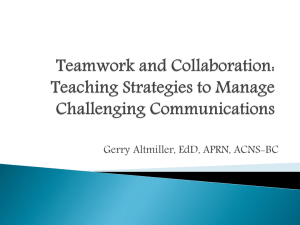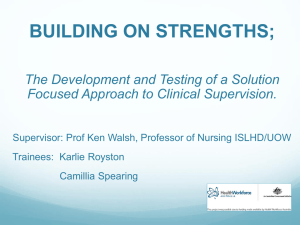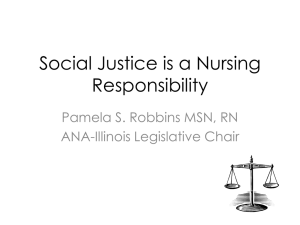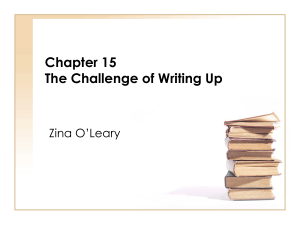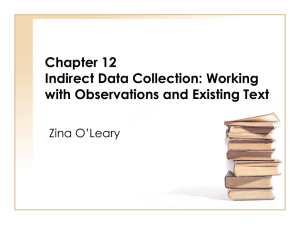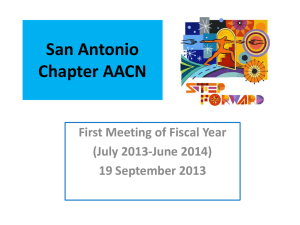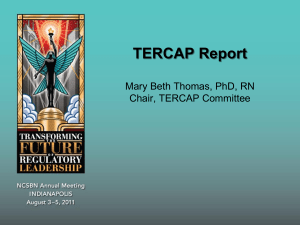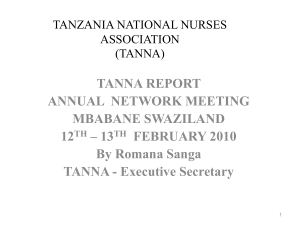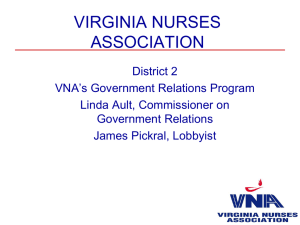Presentation ZINA
advertisement
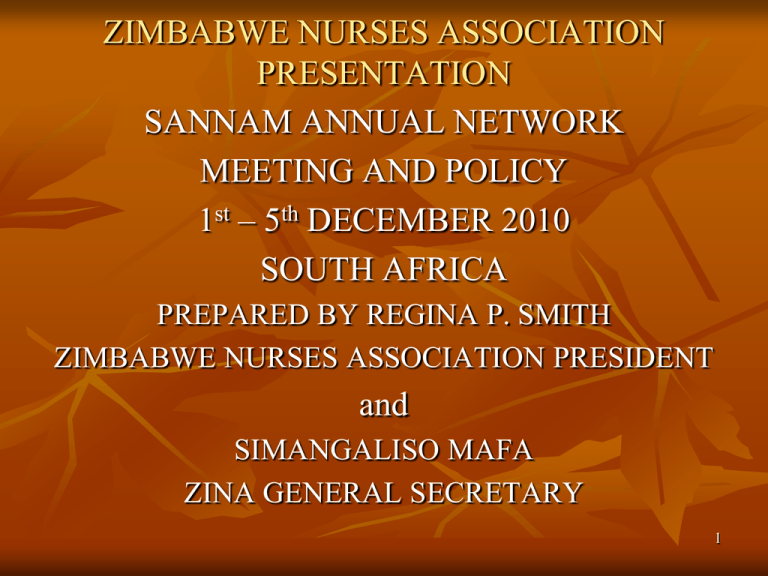
ZIMBABWE NURSES ASSOCIATION PRESENTATION SANNAM ANNUAL NETWORK MEETING AND POLICY 1st – 5th DECEMBER 2010 SOUTH AFRICA PREPARED BY REGINA P. SMITH ZIMBABWE NURSES ASSOCIATION PRESIDENT and SIMANGALISO MAFA ZINA GENERAL SECRETARY 1 Zimbabwe Nurses Association (ZINA) is a vibrant nurses organization for the Republic of Zimbabwe. It was founded in 1980 and currently has a membership of about 4800 out of a possible 16000 members. Membership is voluntary. It is a participatory non-governmental organization. The affairs of the Association are managed by a Standing Committee of 6 members plus 10 Provincial Branch Chairpersons to make up 16 National Executive Committee members, headed by the current association’s President Mrs Regina Smith. 2 Our country has a National Nurses Act with a Nursing Council in place and Code of Ethics. Nurses Council governs the practice of nursing. ZINA constitution was enacted in 1980. ZINA draws its membership from all health institutions in Zimbabwe, Public Sector and Private Sector, all qualified nurses who join receive a full membership status and all student nurses and nurse aides who join receive associate membership status. Retired nurses who remain actively participating in the association may receive honorary membership status. 3 Mission Statement Zimbabwe Nurses Association (ZINA) aims to successfully negotiate for safe working environment and good working conditions that ensure comfort and safety of the patient/client and the nurse in every health care institution in Zimbabwe . Driven by team spirit (ZINA) ensures that it represents nurses in the country through visionary leadership that is sensitive to national health aims, influence health policy, advancing the profession through continuing education, practice and research, partnership enhancement and promoting the highest standard of nursing care. 4 Vision Zimbabwe Nurses Association (ZINA)’s vision is to be the leading Association in Zimbabwe with a membership of not less than 80%. The strength of the Association (ZINA) is to lobby for better working conditions and remuneration to attract retain and recruit more nurses thereby improving nursing care provision to individuals, families and the Zimbabwe community. 5 CURRENT STATUS OF THE ORGANIZATION Zimbabwe Nurses Association (ZINA) as a mother body has subgroups under its umbrella. These groups include the Association of Midwives, Anaesthetists, Occupational Health Nurses, Mental Health Nurse who all are affiliated to ZINA. All these spearhead the nurses cause. Currently the Association is in the process of rebuilding and restructuring after the inception of the new leadership under President Regina P. Smith. 6 Membership is very low due to apathy and poor working conditions which contribute to massive resignations into private sector, region and international market where pastures are said to be greener. Subscriptions to the association is only USD1.00 per member per month which is insufficient to meet the recurrent costs to run the Association. 7 ZINA’s Sources of Income The source of income besides subscription is through selling ZINA regalia like jerseys, scarfs and badges. Main sustainability plans:We plan to have poultry, rabbits projects in every province. Tuck-shops. We plan to erect a 3 storey building behind our offices to accommodate nurses from provinces who would have come for Post Graduate courses. 8 RECENT DEVELOPMENTS Provincial Tours done in February in company of Mrs D. Ngoma from Malawi. Thanks to SANNAM for making the tour a success. Launch of Kadoma Declaration by His Excellency Cde R.G Mugabe in February 2010. This is a landmark achievement which brings Labour, Commerce and Government together to attend to pressing socio-economic issues. ZINA is part and parcel of this agenda. 9 Cont….. ZINA now is part of the Labour Reform Agenda. General Secretary Mr S. Mafa is one of the members appointed to the Tripartite Advisory Board by the Minister of Labour on Labour Reform in Zimbabwe (March 2010). The President of ZINA Mrs R.P Smith was recently appointed (March 2010) to the Public Health Advisory Board by the Minister of Health. 10 Challenges Association still struggling in trying to fund raise for its activities. Association vehicle now old and needs replacement but funds still difficult to get Office equipment is now obsolete it needs replacement Low salaries Poor working conditions 11 Cont…. Donor fatigue Other Health related allowances to retain staff yet to be reinstated after the establishment of multicurrency system. These include among the list Medical Allowance, Post Basic Allowance e.t.c. Labour Migration still experienced. 12 Cont…. The HIV/AIDS pandemic has also taken its toll among nurses. Fortunately, the nurses are not medically boarded but they are counselled and started on ART. Support groups are also formed to help the nurses who are infected and affected. Financial support is very critical to the nurses to form HIV/AIDS groups but the association is failing to help meaningfully because of its current financial status. Massive resignation of Senior Nursing staff for greener pastures affected our membership and services. Human Resources, internal and external brain drain of health professionals is still experienced. 13 Cont…. Civil Society/Donors and NGOs are still skeptical about the Zimbabwean situation so the country is facing a uphill task in promoting and creating enabling environment for investor confidence for donors and NGOs. Health funding is too little leading to poor infrastructure, obsolete equipment which need replacement, shortages of linen, drugs, sundries and other tools of the trade. Re-emergency of infections diseases previously under control like TB. 14 Cont…. The Association continues to lobby for better working conditions for its members who are currently earning an average of USD165,00 per month which is far below the Poverty Datum Line (PDL) of USD502,00. The pathetic salaries have led to massive resignations of mostly Midwives and nurses with specialities. The country is facing financial crisis but the workforce needs reasonable remuneration and this puts the Association under immense pressure to deliver whilst they face hardships from the employer who fails to budge because of lack of financial muscle. 15 Progress Report on Country/Indicators There is a marked improvement in women participation in decision making. Zimbabwe boasts of a lady Vice President and a lady Vice Prime Minister. There are also reasonable Ministries which are headed by ladies like the Ministry of Labour and Gender Ministry. HIV/AIDS prevalence rate has dropped from a high rate of 30% to as low as 12%. Family Planning knowledge is around 98% (Zimbabwe Demographic Health Survey 2007). 16 Cont….. Literacy rate is above 85%. Fertility rate fell from 5.4 births per women in 1998 to 3.8 births per women in 2007. Sadly, Maternal Mortality rate rose from below 100 to above 718/100 000 births. Life expectancy continues to fall and it is now below 40 years. 17 Cont…. Unemployment rate is still above 85%. Public Service salaries are between USD100,00 – USD235,00 per month. Inflation rate is below 4%. Poverty Datum Line is around USD502,00. The Public now access ARVs in Public Institutions for free. We are optimistic that salaries and nurses working conditions will improve soon. 18 Accrued benefits from being SANNAM Affiliate for the Past Three (3) Years SANNAM sponsored the hosting of our 2009 AGM when the Association was in a financial distress. SANNAM sent its President Mr Mafalo to observe our 2009 election which ushered in the current executive. SANNAM sponsored Mrs D. Ngoma to come to Zimbabwe in February 2010 to drum up membership support during provincial tours of our 10 Provinces. This resulted in more than 1000 members joining the Association. 19 …./ The Executive Director of SANNAM and Mrs D. Ngoma attended ZINA Annual General Meeting which was held in October 2010. We continue to cherish their support which gives us power and resilience as we drive our association forward. 20 Our Expectations for SANNAM Support to sister NNA in the form of regular visits, financial, material and psychologically. Lobby for better working condition for nurses and midwives in the region through engaging the SADC Health Ministers. Twinning of NNAs with other International NNAs like it has done in the region. 21 Other Issues The Association is working collaboratively with the Nurses Council of Zimbabwe, Universities and other training colleges of nurses. Sub-groupings under ZINA like the Zimbabwe Confederation of Midwives (ZICOM) are also members of the Association who supports the NNA. Zimbabwe has an established Nursing Directorate and of late we are almost done with the proposal of the Nursing Director to be elevated to the Principal Director Nursing Services. 22 …/ With all the necessary support from the NNAs in the region and abroad, SANNAM and other interested parties we believe our Association will get where we want it to be in less than 5 years. I thank you. 23
